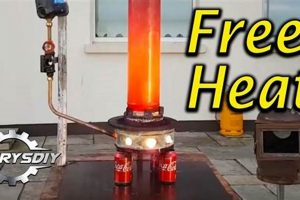A system designed to safely connect a portable generator to a building’s electrical system, often assembled using commercially available components, allows for the selective powering of pre-determined circuits during a utility power outage. An example involves using a specific type of electrical panel and appropriately rated breakers to isolate the generator’s power from the grid while simultaneously providing electricity to designated appliances like refrigerators or heating systems.
Establishing a mechanism for safe generator connection mitigates the risks of backfeeding, which can endanger utility workers and damage equipment. This approach offers a level of electrical independence during emergencies, providing a cost-effective alternative to permanently installed generator systems. The development of standardized transfer switch components has made it easier for individuals with electrical experience to implement such solutions.
The following sections will address the critical components, safety protocols, and common installation practices associated with creating a system for safely using generator power during grid outages. Essential considerations regarding electrical codes and permitting processes are also discussed. Finally, potential challenges and troubleshooting techniques that may arise during installation and operation will be examined.
Essential Guidance for Assembling a Generator Connection System
The following provides crucial guidance for the creation of a manually operated generator connection, emphasizing safety and code compliance. These points are paramount when working with electrical systems.
Tip 1: Consult Local Electrical Codes: Always refer to and adhere to the prevailing electrical codes in the locality. Codes vary and dictate specific requirements for wiring methods, grounding, and permissible installations. Ignoring these codes can lead to hazards and legal repercussions.
Tip 2: Utilize a Listed and Labeled Transfer Switch: Employ only transfer switches that have been certified by a nationally recognized testing laboratory (NRTL). A label signifies that the device has undergone rigorous testing and meets established safety standards. Avoid uncertified, homemade devices.
Tip 3: Ensure Proper Grounding: Proper grounding is vital for safety. Ground the generator according to the manufacturer’s instructions and ensure the grounding system is bonded to the building’s grounding electrode system. This protects against electrical shock and equipment damage.
Tip 4: Implement Overcurrent Protection: Use appropriately sized circuit breakers or fuses to protect circuits from overloads and short circuits. The generator’s output should be properly matched to the rating of the breakers to prevent damage to the generator or the connected loads.
Tip 5: Verify Voltage and Phase Compatibility: Ensure that the generator’s voltage and phase are compatible with the building’s electrical system. Connecting incompatible voltage or phase systems can result in severe damage to equipment and create a fire hazard. Most residential systems are single-phase 120/240V.
Tip 6: Employ a Qualified Electrician: For those lacking extensive electrical experience, engage a licensed electrician to review the plan, perform the installation, and ensure the system operates safely and in compliance with applicable codes. This ensures professional work and peace of mind.
Tip 7: Test the System Thoroughly: After installation, rigorously test the system under various load conditions to verify its functionality and identify any potential problems. Conduct periodic testing to ensure continued reliability.
Adherence to these crucial tips can significantly enhance the safety and reliability of a generator connection system. Neglecting these recommendations risks significant electrical hazards.
Proceeding with the understanding of the preceding tips, the article will transition towards a detailed explanation of component selection and practical applications.
1. Component Selection
Component selection is a critical determinant of the overall safety and efficacy of a manually assembled generator connection system. Each component, from the transfer switch itself to the circuit breakers and wiring, must be appropriately rated and selected for the intended application. The cause-and-effect relationship is direct: substandard components lead to compromised safety and potential equipment failure. For example, using undersized wiring can result in overheating and fire, while an incorrectly rated transfer switch may fail to adequately isolate the generator from the utility grid, resulting in backfeeding, a dangerous phenomenon that can endanger utility workers and damage equipment. The selection of listed and labeled components from reputable manufacturers is paramount to ensure adherence to safety standards and reliable operation.
The transfer switch’s amperage rating must match or exceed the generator’s output and the connected circuit’s capacity. Similarly, circuit breakers must be correctly sized to protect individual circuits from overloads. Wiring must be of the appropriate gauge to handle the anticipated current draw without overheating. A real-life example is the selection of a 30-amp transfer switch and corresponding 30-amp breaker for a generator with a 30-amp output. In contrast, trying to use a 20-amp switch would overload the system, potentially damaging the generator or creating a fire hazard. Understanding the practical significance of appropriate component selection is essential for safe and reliable backup power during grid outages. Consideration must also be given to environmental factors, such as temperature and humidity, which can affect component performance.
In summary, the selection of components directly impacts the safety and performance of any generator connection. Erroneous choices can have grave consequences, underlining the need for thorough research, adherence to electrical codes, and, ideally, consultation with a qualified electrician. Selecting the correct components will ensure the system delivers power safely and effectively. Understanding these concepts is crucial in ensuring the longevity and efficacy of the backup power solution.
2. Safety Protocol
The implementation of rigorous safety protocols is inextricably linked to the safe and reliable operation of any manually assembled generator connection system. Disregard for established safety practices introduces the potential for severe electrical hazards, including electrocution, fire, and equipment damage. A cause-and-effect relationship exists: deviation from accepted safety protocols inevitably increases the risk of adverse events. Safety protocols are not merely suggestions; they are essential components of a functioning and safe generator connection. For example, failure to properly disconnect the main b
reaker before engaging the generator can result in backfeeding, where generator power flows back into the utility grid, creating a lethal hazard for utility workers.
Consider the lockout/tagout procedure. This protocol mandates the de-energization and physical locking of the main breaker during generator operation, preventing accidental reconnection to the grid. Similarly, the use of appropriately rated personal protective equipment (PPE), such as insulated gloves and safety glasses, mitigates the risk of electrical shock and arc flash. A practical example involves the verification of voltage absence before commencing any wiring work. Employing a non-contact voltage tester can confirm that circuits are de-energized, preventing accidental contact with live wires. The absence of such protocols creates a high-risk environment.
In summation, safety protocols represent the cornerstone of a safe manually assembled generator connection system. Ignoring these protocols introduces unacceptable risk. The consistent application of established safety practices is crucial for preventing accidents, protecting personnel, and ensuring the reliable provision of backup power. Challenges in this area often stem from a lack of training or a disregard for established procedures. However, comprehensive training, rigorous adherence to safety guidelines, and ongoing vigilance are essential for mitigating risks.
3. Code Compliance
Adherence to established electrical codes is paramount in any manually assembled generator connection system. These codes, often derived from national standards like the National Electrical Code (NEC), dictate the safe and permissible installation methods, materials, and practices. The absence of code compliance introduces significant safety hazards and potential legal ramifications.
- Permitting Requirements
Many jurisdictions mandate permits for electrical work, including the installation of generator transfer switches. Obtaining a permit involves submitting plans for review and undergoing inspections to ensure compliance with local codes. Failure to secure necessary permits can result in fines, mandatory system modifications, and potential liability in the event of an accident. For instance, a homeowner installing a transfer switch without a permit may be held responsible for any damages or injuries resulting from a faulty installation.
- Wiring Methods and Materials
Electrical codes specify acceptable wiring methods and materials for different applications. For generator connections, this includes the type and gauge of wiring, conduit requirements, and grounding practices. Improper wiring can lead to overheating, electrical shorts, and fire hazards. An example includes using the incorrect type of wire, such as indoor-rated wire for outdoor use, which is susceptible to degradation and failure.
- Grounding and Bonding
Proper grounding and bonding are critical for electrical safety. Codes dictate how generators and transfer switches must be grounded to prevent electrical shock and protect against equipment damage. Improper grounding can create a path for stray currents, increasing the risk of electrocution. An example is failing to bond the generator’s frame to the building’s grounding electrode system, which can leave the generator’s metal parts energized during a fault.
- Overcurrent Protection
Electrical codes mandate the use of appropriately sized circuit breakers or fuses to protect circuits from overloads and short circuits. These devices interrupt the flow of electricity when a fault occurs, preventing damage to equipment and reducing the risk of fire. Using the wrong size breaker can defeat this protective function. An example would be installing a 20-amp breaker on a circuit designed for 15 amps; this eliminates the proper protection the 15 amp circuit provides.
These considerations highlight the necessity of understanding and adhering to electrical codes when installing a generator connection system. Compliance not only ensures safety but also protects property and avoids legal issues. Given the complexities of electrical codes, it is often advisable to consult with a qualified electrician to ensure proper installation and compliance.
4. Grounding System
A properly implemented grounding system forms an indispensable safeguard within a user-assembled generator connection setup. Its role extends beyond mere compliance, directly affecting personnel safety and equipment protection during operation. Neglecting or improperly executing the grounding provisions can introduce substantial electrical hazards, negating the intended safety benefits of the entire system.
- Generator Grounding Electrode Conductor (GEC)
The generator grounding electrode conductor provides a low-impedance path for fault currents to return to the source, thereby facilitating the operation of overcurrent protection devices. This conductor connects the generator’s frame to a grounding electrode, typically a ground rod driven into the earth. An example includes utilizing a properly sized copper conductor (e.g., #8 AWG or larger, depending on generator output) securely connected to both the generator’s grounding lug and the grounding electrode. Its absence or inadequate sizing prevents proper fault current flow, increasing the risk of electric shock.
- Bonding of Non-Current-Carrying Metal Parts
Bonding ensures that all non-current-carrying metal parts within the electrical system, such as enclosures and conduit, are electrically connected to each other and to the grounding electrode. This minimizes voltage differences between these parts, reducing the potential for electric shock. For instance, metal conduit runs and electrical box enclosures must be bonded together using approved connectors and bonding jumpers. Failure to properly bond these components can create a hazardous voltage gradient, posing a shock risk to anyone coming into contact with them during a fault.
- Neutral-Ground Bond (Generator-Specific Considerations)
The location of the neutral-ground bond is crucial in generator systems. Typically, only one neutral-ground bond should exist within a system to prevent circulating ground currents. In the context of a user-assembled generator connection, the generator may or may not have an internal neutral-ground bond. If the generator does have such a bond, and the building’s service also has one, it may be necessary to remove the bond in the generator during transfer switch operation. Consult the generator’s documentation and a qualified electrician to determine the correct configuration, because improper bonding can lead to nuisance tripping of circuit breakers and increased electrical noise.
- Ground Fault Circuit Interrupter (GFCI) Protection
Ground Fault Circuit Interrupters (GFCIs) provide an additional layer of protection by detecting small imbalances in current flow between the hot and neutral conductors. A GFCI will quickly interrupt the circuit if a ground fault is detected, preventing electrical shock. GFCIs are typically required in areas where electrical equipment may come into contact with water, such as outdoor receptacles used to plug in the generator. GFCIs offer enhanced safety, especially when operating electrical equipment in damp environments.
The effective integration
of these facets within the grounding system is crucial for ensuring a safe DIY generator setup. Each facet addresses specific potential hazards, and their combined implementation provides a comprehensive safety net. Failure to address any of these elements compromises the overall integrity of the grounding system, increasing the risk of electrical accidents and equipment damage. A properly configured grounding system supports electrical safety, promotes equipment reliability, and ensures code compliance.
5. Circuit Isolation
Circuit isolation is a fundamental safety requirement in any manually constructed generator connection system. Its purpose is to prevent the generator’s output from energizing the utility grid (backfeeding) and to protect the generator from potential damage caused by utility power surges when the grid is restored. Proper circuit isolation ensures that the generator only powers selected circuits within the building, maintaining electrical safety for both the user and utility personnel.
- Main Breaker Interlock
A mechanical interlock prevents simultaneous operation of the main breaker (connecting to the utility grid) and the generator breaker. This device typically consists of a sliding plate or similar mechanism that physically blocks one breaker from being turned on while the other is active. For instance, when the generator breaker is engaged, the interlock prevents the main breaker from being switched on, thus preventing backfeeding. Conversely, when the main breaker is on, the generator breaker is mechanically blocked from being activated. An effective interlock system provides a robust and reliable means of circuit isolation.
- Double-Pole, Double-Throw (DPDT) Switch
A DPDT switch provides a manual method of transferring power between the utility grid and the generator. This switch has two sets of contacts that simultaneously switch between two different circuits. In a generator setup, one set of contacts connects to the utility grid, while the other connects to the generator. When the switch is in the “utility” position, the building receives power from the grid; when switched to the “generator” position, the building receives power from the generator. This ensures that only one power source can energize the selected circuits at any given time, achieving circuit isolation.
- Transfer Switch with Break-Before-Make Contacts
A transfer switch equipped with break-before-make contacts ensures that the generator and utility power are never connected simultaneously. This type of switch breaks the connection to one power source before establishing a connection to the other. This prevents any momentary paralleling of the generator and the utility grid, which could cause voltage fluctuations and potential equipment damage. The break-before-make design is crucial for maintaining circuit isolation and preventing unintended power flow.
- Clearly Labeled Circuitry
Clearly labeling all circuits connected to the transfer switch is crucial for safe and effective operation. Each circuit should be clearly identified as either “generator-powered” or “utility-powered” to prevent confusion during a power outage. For example, labels might indicate which circuits power essential appliances such as refrigerators, freezers, or medical equipment. Clear labeling allows the user to quickly and accurately select the desired circuits to power with the generator, minimizing the risk of overloading the generator or accidentally energizing circuits that should remain isolated.
In summation, circuit isolation is a non-negotiable element of a safe generator connection system. Whether achieved through mechanical interlocks, DPDT switches, break-before-make transfer switches, or clear circuit labeling, the goal remains the same: to prevent backfeeding and protect both the user and the equipment. Each facet plays a distinct role in ensuring that the generator’s power remains isolated from the utility grid, thereby contributing to the overall safety and reliability of the system.
6. Load Management
Efficient load management is intrinsically linked to the safe and effective utilization of any user-assembled generator connection system. The power output of a portable generator is finite; exceeding this capacity can lead to generator overload, potential damage to connected appliances, and system failure. Therefore, understanding and implementing effective load management strategies is crucial.
- Circuit Prioritization
Circuit prioritization involves identifying essential circuits within the building that require backup power during an outage. These circuits typically include lighting, refrigeration, heating systems, and medical equipment. By limiting the number of circuits connected to the generator, the overall load is reduced, preventing overload. An example involves segregating lighting circuits, designating only a few key lights for generator power while disconnecting non-essential fixtures. This prioritization ensures that critical systems receive uninterrupted power.
- Wattage Calculation and Monitoring
Calculating the wattage requirements of each connected appliance and monitoring the total load on the generator is essential for preventing overloads. This involves summing the wattage of all appliances that will be running simultaneously. Many appliances have wattage information on a nameplate. Employing a power meter or energy monitor can provide real-time feedback on the generator’s load. For example, if a generator has a continuous output of 5000 watts, the combined wattage of all connected appliances should not exceed this limit. If it does, loads need to be shed to prevent damage. This continuous monitoring and careful load management can prevent premature generator failure.
- Staggered Startup
Staggered startup refers to the practice of energizing appliances sequentially rather than simultaneously. Some appliances, such as refrigerators and air conditioners, require a higher surge of power during startup than during continuous operation. By starting these appliances one at a time, the peak load on the generator is reduced. For instance, starting a refrigerator 15 minutes before an air conditioner allows the generator to stabilize before handling the additional load. This approach mitigates the risk of overload and ensures stable power delivery.
- Load Shedding Devices
Load shedding devices automatically disconnect non-essential loads when the generator approaches its maximum capacity. These devices monitor the generator’s output and, when a pre-set threshold is reached, disconnect designated circuits. For instance, a load shedding device could automatically disconnect an electric water heater or clothes dryer if the generator is nearing its maximum load. This ensures that essential circuits continue to receive power while preventing the generator from being overloaded. Automated load shedding provides a reliable and hands-free approach to load management.
Efficient load management is pivotal for optimizing the performance and lifespan of a manually assembled generator connection system. Careful circuit prioritization, accurate wattage calculation, strategic staggering of startup, and the potential integration of load shedding devices collectively contribute to a system that delivers reliable bac
kup power without exceeding the generator’s capacity. The effective application of these techniques transforms a potentially risky and unreliable setup into a safe and dependable emergency power solution. Proper management ensures that the available power is used efficiently and effectively, minimizing the risk of damage or failure. The synergy between responsible load management and a properly constructed generator connection forms a robust defense against grid outages.
Frequently Asked Questions
The following addresses common inquiries regarding manually assembled generator connection systems, providing clarity on key aspects related to their design, operation, and safety.
Question 1: Is a manually assembled generator connection system legal?
The legality of a manually assembled generator connection system hinges on adherence to local and national electrical codes. Failure to comply with applicable regulations can result in fines and mandated system modifications. A qualified electrician can verify compliance and guide the permitting process.
Question 2: What are the primary dangers associated with an improperly installed generator connection?
Improperly installed systems pose several dangers, including backfeeding into the utility grid, electrical shock, fire hazards, and damage to connected appliances. Backfeeding is particularly dangerous as it can electrocute utility workers. The risk can be mitigated by consulting a professional.
Question 3: Can any type of transfer switch be used in a manually assembled system?
Only transfer switches listed and labeled by a nationally recognized testing laboratory (NRTL) should be employed. Uncertified or homemade devices lack the necessary safety features and present a significant risk. Listed components provide verified safety.
Question 4: How is the generator grounded in a manually assembled connection system?
The generator must be grounded according to the manufacturer’s instructions and in accordance with electrical codes. This typically involves connecting the generator’s frame to a grounding electrode, ensuring a low-impedance path for fault currents. Improper grounding can lead to electrocution hazards.
Question 5: What is the purpose of circuit isolation in a generator connection?
Circuit isolation prevents the generator’s output from energizing the utility grid (backfeeding) and protects the generator from potential damage caused by utility power surges. This is typically achieved through a mechanical interlock or a transfer switch. Proper isolation is essential for safety.
Question 6: How can generator overload be prevented?
Generator overload can be prevented through load management techniques, including circuit prioritization, wattage calculation, staggered startup of appliances, and the use of load shedding devices. Understanding the generator’s capacity and the power requirements of connected appliances is crucial.
In summary, a manually assembled generator connection system requires meticulous attention to detail, adherence to electrical codes, and the implementation of rigorous safety protocols. The absence of any of these elements can compromise the safety and reliability of the system.
The article will now transition to a detailed examination of troubleshooting common issues that may arise during the installation and operation of generator connection systems.
DIY Generator Transfer Switch
This exploration of the diy generator transfer switch concept has emphasized the critical importance of safety, code compliance, and meticulous execution. The assembly of such a system necessitates a comprehensive understanding of electrical principles, component selection, and grounding techniques. Furthermore, effective load management and stringent adherence to established safety protocols are non-negotiable prerequisites for a reliable and secure backup power solution.
The decision to implement a diy generator transfer switch should not be undertaken lightly. Given the potential hazards involved, engaging a qualified electrician for consultation, installation, and inspection is strongly recommended. The integrity of the electrical grid, personal safety, and the prevention of property damage outweigh any perceived cost savings associated with a purely do-it-yourself approach. The safe and responsible application of electrical knowledge remains paramount.







